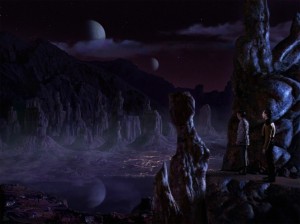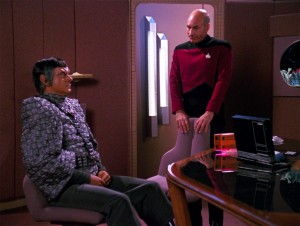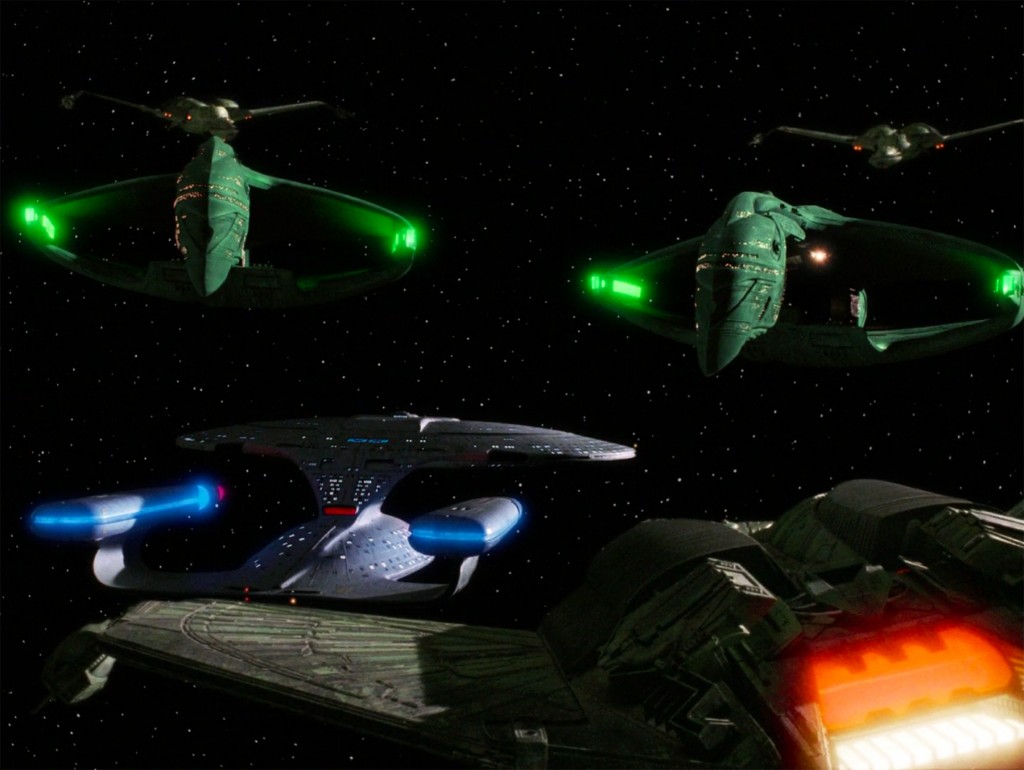Yep. I got bit by the ‘TNG ‘ bug last time, so we’re back for another round. This time, we’ll be taking a look at the third season episode ‘The Defector’.
Last time I talked a bit about the third season and how it was the year the show finally “got good”. In that column, I was a little more focused on the continued increase in quality going into the fourth season, but that shouldn’t be taken to diminish the third. While the fourth season arguably saw the show at the height of its powers, the third was nonetheless an overall excellent season and a quantum leap ahead of what had come before. This was in no small part to the changing face of the writing staff. When ‘The Next Generation’ premiered, the writing and production teams included a several veterans of the original series, but heavy turnover over the next two years made it that much more difficult for the show to find its stride. The arrival of Michael Piller, Ronald D. Moore, and Ira Steven Behr (among others) early in the third season would change that, however, and shape the face of ‘Star Trek’ for much of the next fifteen years. In particular, their influence turned ‘The Next Generation’ into a more nuanced show that it had been previously, with episodes like this standing in sharp relief to even the best that the first two seasons have to offer.
A Romulan scout ship flees across the Neutral Zone with a Warbird in hot pursuit. When the heavily damaged scout crosses into Federation space, The Enterprise is able to intervene, extending her shields around the scout ship. As it becomes clear that the Enterprise is prepared to stand between them and their prey, the Warbird retreats to Romulan territory. The pilot of the scout ship is beamed to safety and demands to see the Captain. He identifies himself as Sublieutenant Setal, a logistics officer who is defecting in order to warn Starfleet that the Romulans have covertly established a base in the Neutral Zone and that within a matter of days an entire fleet will be ready to cross into Federation territory. Riker and Data note scenarios – one in which Setal is lying and in which he is telling the truth – in which this could be an elaborate ruse intended to goad the Federation into starting a war. Neither scenario, as Data points out, would be out of character for the Romulans. Once alone in his quarters, Setal examines a small object concealed in his boot.
 While Starfleet reinforcements are on the way, they are unlikely to arrive in time, leaving the Enterprise charged with getting to the bottom of things and preventing a war. Suspicions mount as, upon reviewing sensor logs of the pursuit, LaForge realizes that the Warbird deliberately held back from overtaking the scout ship, with Data adding that they may have intentionally missed when firing on the scout and Crusher confining the possibility (despite her skepticism) that Setal’s injuries could have been self-inflicted.
While Starfleet reinforcements are on the way, they are unlikely to arrive in time, leaving the Enterprise charged with getting to the bottom of things and preventing a war. Suspicions mount as, upon reviewing sensor logs of the pursuit, LaForge realizes that the Warbird deliberately held back from overtaking the scout ship, with Data adding that they may have intentionally missed when firing on the scout and Crusher confining the possibility (despite her skepticism) that Setal’s injuries could have been self-inflicted.
Setal remains cagey as Riker and Troi interrogate him. Characterizing himself as a “loyal Romulan”, he offers only a minimum of information, dismissing many of Riker’s questions by claiming ignorance or insisting that they are irrelevant. As the Enterprise approaches Nelvana III, the site of the supposed base, they receive a message from a Klingon vessel. A probe sent to Nelvana detects what might be evidence of cloaked ships, but the readings are inconclusive and can only be confirmed in person. Meanwhile in Ten Forward, Data speaks with Setal. As the conversation turns to the defector’s growing homesickness, Data takes him to the holodeck to visit a simulated Romulus. Though well-intended, this gesture only underscores everything he has sacrificed, and the defector tells Data to arrange a meeting with the Captain before finally confirming his identity not as Sublieutenant Setal, but Admiral Jarok.
Jarok, an officer with a notorious military career, explains to Picard that he adopted a false identity precisely because he didn’t expect Starfleet to trust him (given his reputation) and that his decision to defect was motivated by a desire to leave a better world for his daughter. Jarok adds that he has been trying for some time to dissuade the Romulan government from embarking on another war, to the point that he was ignored, censored, and ultimately felt it necessary to cross the lines. Realizing what he must do to earn Picard’s trust, Jarok, at last, provides vital information on the strength, plans, and location of the Romulan fleet.
Armed with this information, Picard takes the Enterprise into the Neutral Zone on a course for Nelvana III. On arrival, they find… nothing. Jarok is baffled, as he saw tactical communiques placing an entire legion at Nelvana. Picard realizes that Jarok was being fed misinformation to test his loyalty. As the Enterprise prepares to disembark, two Warbirds decloak and open fire. The lead Warbird hails the Enterprise to demand their surrender. As words give prepare to give way to phasers, Picard signals Worf, and at his cue, a trio of Klingon warships decloak. With the odds suddenly evened, all six ships withdrawal from the Neutral Zone. Realizing that his sacrifices were all for naught, Jarok returns to his quarters and commits suicide using the device he kept in his boot, leaving behind a letter for his family. While it is now impossible to deliver that letter, Picard observes that if there are others with Jarok’s courage, the day may yet come when they can.
 This is an excellent episode, and although it’s only Moore’s second ‘Star Trek’ credit (and according to the writer himself, the episode was more of a team effort than most), fans of both the reimagined ‘Battlestar Galactica’ and ‘Star Trek: Deep Space Nine’ will recognize his fingerprints all over it. Described by writer Moore as “the Cuban missile crisis at the Neutral Zone”, it deals with escalating tensions both small (Should the crew trust Jarok?) and large scale (Just what are the Romulans up to?), confronting questions of trust issues that arise from a centuries long cold war. Though Moore’s favored themes of the moral ambiguities of war and the humanity of those forced to fight it would shine through much more clearly in his later work, they are undeniably present here.
This is an excellent episode, and although it’s only Moore’s second ‘Star Trek’ credit (and according to the writer himself, the episode was more of a team effort than most), fans of both the reimagined ‘Battlestar Galactica’ and ‘Star Trek: Deep Space Nine’ will recognize his fingerprints all over it. Described by writer Moore as “the Cuban missile crisis at the Neutral Zone”, it deals with escalating tensions both small (Should the crew trust Jarok?) and large scale (Just what are the Romulans up to?), confronting questions of trust issues that arise from a centuries long cold war. Though Moore’s favored themes of the moral ambiguities of war and the humanity of those forced to fight it would shine through much more clearly in his later work, they are undeniably present here.
In fact, Jarok himself is no small part of what makes the episode work as well as it does, with James Sloyan delivering a performance that can only be described as Shakespearean. Despite only having an hour to get to know him, we see several different facets of Jarok, whether he’s trading barbs with Worf, or gazing wistfully on the simulated vistas of Romulus with Data, we come to the man even before we truly know who he is. And once his true identity is revealed along with his reasons for defecting, he becomes an ever more sympathetic figure, despite his earlier belligerence and military reputation. And while all of that may have been on the page, much of the credit has to go to Sloyan himself. When I was picking an episode to cover this week, I started by deciding that I wanted to do something with Romulans, and when I thought of ‘The Defector’, it was Sloyan’s performance that first came to mind.
Another of the episode’s high points is the score by Ron Jones. Better known today for his work on Seth McFarlane’s various animated shows, Jones composed for ‘TNG’ throughout the first four seasons. Arguably the best of the composers to work on the show (all of whom were more than capable), Jones brought a distinct style to his scores, approaching each episode more like a feature film than an hour of TV.
But this isn’t just a great episode, it is a perfect example of why I love the Romulans. Though they were first introduced in the early days of the original ‘Star Trek’, they tended to be somewhat interchangeable with the Klingons of the era, with both acting as the other half of a Cold War allegory (with the Federation, naturally, standing in for the USA). On ‘The Next Generation’, the two races finally came into their own. With the Klingons developing into a mixture of samurai and Vikings… in space, the Romulans became the exact opposite, charming yet duplicitous, always looking for the upper hand, and as ‘The Defector’ makes clear, preferring whenever possible to manipulate their enemies into firing the first shot. Put another way, a Klingon will run you through with a sword, but a Romulan will kiss you with poison lipstick. And as much fun as the Klingons are, one of those just makes for a more intrinsically interesting villain than the other. In fact, the utter misuse of the Romulans (in more ways than one) is among my many problems with the first JJ Abrams movie. But that’s a rant for another column, one that I might finally get around to when I run out of things that I enjoy watching.
What are your thoughts on ‘The Defector’? Are there any specific episodes you’d like to see me cover? Speak up in the comments, and check back in two weeks for the next installment of ‘Final Frontier Friday’!

